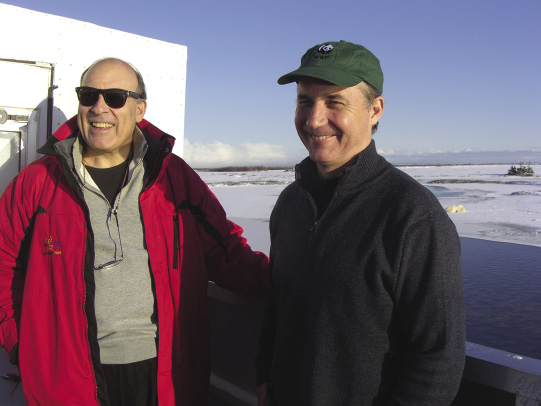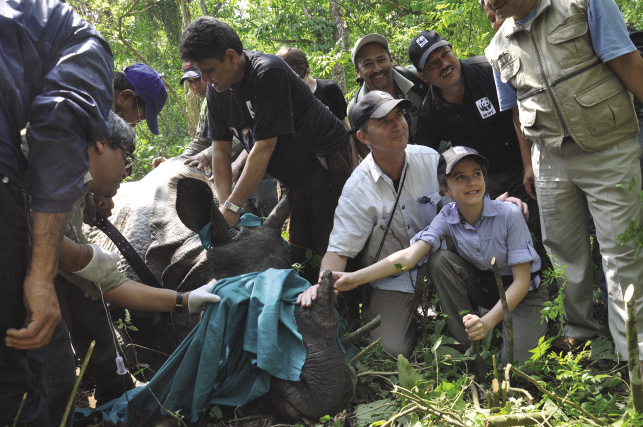


![]()
ONLINE


Carter Roberts (on right) with Muhtar Kent,
Chairman and CEO of The Coca-Cola Company
in the Arctic in 2011
Saving the Planet
Editors’ Note
Carter Roberts’ path to conservation began with a love for climbing mountains. En route, he worked for Procter & Gamble and received an M.B.A. from Harvard Business School. He went on to lead international and science programs at The Nature Conservancy before coming to WWF in 2004. He has tracked the rarest creatures to the far ends of the earth; has worked with communities and heads of state in North America, Africa, Latin America, and Asia; and has signed agreements with some of the world’s largest corporations to set new industry standards for resource efficiency. Carter has written both academic papers and informal blogs for numerous publications ranging from Fast Company to Conservation Letters. He serves on the boards of the Nicholas Institute for Environmental Policy Solution at Duke University and the Grantham Institute for Climate Change at Imperial College and the London School of Economics, and is a member of International Finance Corporation’s Advisory Panel on Sustainability and Business.
Organization Brief
World Wildlife Fund (www.worldwildlife.org; WWF) is the world’s leading conservation organization, working in 100 countries for half a century. With the support of almost five million members worldwide, WWF is dedicated to delivering science-based solutions to preserve the diversity and abundance of life on Earth, halt the degradation of the environment, and combat climate change.

Carter Roberts with his daughter Eliza in Nepal
in 2012, tranquilizing and fitting a rehabilitated rhino
with a GPS satellite collar for translocation
and conservation tracking purposes (right)
What is the mission and vision for the World Wildlife Fund and how have your efforts evolved over the years?
Our vision is to build a future in which people and nature flourish. Early on, we focused on saving animals like rhinos and tigers from extinction. Over time, we have come to realize how much people depend upon the natural capital in the world and we have increasingly focused on embedding the value of nature in the decisions that governments and businesses make.
The fastest growing part of our focus is working with the biggest businesses on earth on their supply chains.
Have the leading companies understood the importance of these efforts?
When we look at the places around the world that we care about – the Amazon, the Mekong River, the Arctic – the two biggest issues are climate change and resource scarcity.
There are 15 commodities that make a huge difference in the future of these places. We identified the 100 biggest companies like Walmart and Coca-Cola that buy and trade these commodities and we systematically engaged them in making measurable commitments and partnering with us. We now have Memoranda of Understanding with 56 of those 100 companies to work on sustainability.
For example, the partnership we built with Muhtar Kent and the Coca-Cola company set measurable goals to improve their water efficiency by 20 percent, to reduce CO2 emissions, and to impact their supply chain, particularly around the production of sugarcane.
We’re expanding our work with them to use their brand, which is the biggest in the world, and our brand, which is the biggest in the environmental field, to engage consumers in understanding issues like water conservation and climate change, and to help give people tools to make decisions in their everyday lives.
Does the relationship within these organizations need to be at the C-Suite level to get the engagement?
A new addition to the C-Suite is the Chief Sustainability Officer, because many of these companies are developing 50-year plans. The discussion has moved beyond philanthropy and corporate responsibility to where it is now a strategic issue.
How have you driven the mission?
We now have a dream team in Washington, D.C. made up of people primarily with business backgrounds who do nothing but work on these partnerships with companies.
We have left behind the old idea that business is the enemy, particularly with some of the challenges we now face in getting the leadership we need from governments around the world; it’s the private sector that gives us the most hope in addressing some of these huge global issues.
Are you optimistic that we’re adequately addressing issues like climate change?
I see the world’s leading companies making commitments to address these issues; Mexico and South Africa are putting a price on carbon and it’s a matter of time before our government and others do the same.
Everyone at WWF has a conviction that if we just put together the right science with the right businesses and governments, the solutions will present themselves – we just have to put them in place.
Has this strategy been received as you had anticipated when you developed it?
When we put this strategy together, we knew it was important. I didn’t predict we would get the response we did from these companies where they now see it as fundamental to their business model.
Two years ago in Davos, 45 companies in the consumer goods sector committed to removing deforestation from their supply chain by 2020 and to remove chlorofluorocarbons from their refrigeration units – that is huge.
Should more be done to get the message out about the impact of these private companies?
People typically measure the resources we directly devote to these issues, but the real leverage is in the billions of dollars these companies are devoting through their supply chains and corporation initiatives, and how they leverage them for these causes. There still is no substitute for the right regulatory framework or for putting a price on carbon. All of these companies still look to Washington and to Beijing to send the right signals, and to create the right regulatory framework and the right incentives to level the playing field, but we also need to move full sectors. Businesses still need government and leaders like Mayor Bloomberg to enact policies that support what the good guys are doing.
Is there a clear definition of what sustainability truly encompasses?
Sustainability is using what the planet can sustain over the long run. We have to find new ways to use energy, water, and land that enable us to meet our needs without destroying the planet.
The good news is that in any one of these commodities, the best producers produce 10 times as much on an acre of land as the worst producers. The solutions are right in front of us. It’s a question of using our purchasing power, our supply chains, and our policies to get there.
Are you surprised that you ended up in this role?
I always dreamed of bringing my work in business together with saving the planet. I’m asked by young people, “Should I start my career in business, in government or in nonprofit?” and I always say, it doesn’t matter – the main thing is that you develop the skills to connect the dots among those sectors. Because the answers lie in bringing all three of those sectors together.•